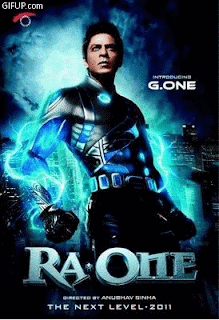Masters of illusion:Ra.One is a symbol for the levels of excellence achieved by the indian VFX industry
The film's release is still months away, but the trailer has already created a buzz. And judging by the trailer, whatever the final commercial and critical verdict on Shah Rukh Khan's forthcoming science fiction Ra.One, it will go down in Indian film history as the movie which has used computer generated visual effects footage the most in Indian cinema so far, putting even last year's Rajinikanth blockbuster Enthiran or Robot in the shade.
Everyone is gushing about the Ra.One's visual effects, or VFX. Even Hollywood is impressed. "New minute of Captain America visuals pales in comparison to the 10-second Ra. One teaser," says Movieline, an international website that reviews film trailers. So too director Shekhar Kapur, whose Mr India made in 1987 was one of the first Indian films to use VFX, tweeted: "Shah Rukh's Ra.One has raised the bar on VFX technique in Indian cinema... Hope other filmmakers catch up!"
Ra.One is a pointer to not only the levels of excellence achieved by the Indian VFX industry, but also to Indian cinema's increasing use of VFX technology. For many years, Indian VFX units catered mainly to Hollywood and ad film makers in India, with feature film directors - barring a few exceptions - keeping their distance. Suddenly, attitudes have changed.
Ra.One is a pointer to not only the levels of excellence achieved by the Indian VFX industry, but also to Indian cinema's increasing use of VFX technology. For many years, Indian VFX units catered mainly to Hollywood and ad film makers in India, with feature film directors - barring a few exceptions - keeping their distance. Suddenly, attitudes have changed.
Among the high-profile films of late that used VFX extensively are Chandni Chowk to China (1,500 VFX shots), Aladin (1,600 shots), Blue (800 shots), Guzaarish (350 shots) and above all, Enthiran (2,000 shots). Currently, industry insiders estimate around 70 per cent of Indian films are using VFX.
"In Bollywood, VFX has evolved only in the last five years," says Merzin Tavadia, co-founder and Chief Creative Director, India, of Prime Focus, a leading VFX and postproduction studios that is working on the 3D conversion of The Phantom Menace of the Star Wars series. The first Hindi film to do so on a large scale was the 2008 release Love Story 2050. "It had 1,200 VFX shots. The film bombed, but the VFX was something Bollywood had never seen before," Tavadia adds.
"In Bollywood, VFX has evolved only in the last five years," says Merzin Tavadia, co-founder and Chief Creative Director, India, of Prime Focus, a leading VFX and postproduction studios that is working on the 3D conversion of The Phantom Menace of the Star Wars series. The first Hindi film to do so on a large scale was the 2008 release Love Story 2050. "It had 1,200 VFX shots. The film bombed, but the VFX was something Bollywood had never seen before," Tavadia adds.
Indeed, even the subsequent Indian films that relied heavily on VFX had mixed fortunes at the box office. But all that changed with Enthiran, which was a tremendous success, raking in Rs 350 crore worldwide. And now there is Ra.One, which industry sources say has around 3,500 VFX shots, outstripping not only Enthiran in this respect, 2008 230 but even the much-discussed Hollywood blockbuster James Cameron's Avatar, whose score was around 2,700 shots. Haresh Hingorani, its VFX supervisor, says: "The most difficult of shots in Ra.One were the ones that required Shah Rukh's 'suit enhancement', which means combining actual shots taken using a camera with VFX shots. There are 800 suit shots and it took us five months to develop the pipeline for them."
Bollywood (Ra.One is an exception) has some way to go before it catches up with Hollywood. For a VFXdriven film, rarely do Indian producers budget more than 10 per cent for the effects, while their Hollywood counterparts could earmark as much as 60 to 70 per cent. Then, there is the size of budget, itself. Hollywood studios can spend $200 to 250 million on VFX alone, while the entire budget of Enthiran, for instance, was around Rs 160 crore or $36 million. "We tried to deliver visual effects of international standards within budget constraints," says V. Srinivas Murali Mohan, the film's VFX supervisor
"In Hollywood, once scripts are written in which VFX is an integral part, the process automatically takes over." Not in India. Enthiran, says Mohan, spent six to seven months on pre-visualisation. "Indian cinema is still raw in the way it views VFX," says Keitan Yadav, Ra.One's VFX producer. "For directors and producers, getting involved at the script stage and pre-visualising is not the norm yet. However, things are changing and Ra.One is an example."
Not just the next five - VFX will grow for many years to come. The sight of unbelievable events unfolding believably on screen is guaranteed to fascinate all, especially children. Back to Ra.One, which its director Anubhav Sinha admits is being made "as a treat for our kids". Shah Rukh's son Aryan is 13, his daughter Suhana is 10, while Sinha's own son, Shlok, is nine. "Ra.One is a father-son story. We wanted to do it for our children," concludes Sinha.
Thanks to Business today & you can read more about VFX at Business Today

Comments
Post a Comment
What do you think of this ?